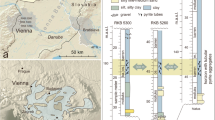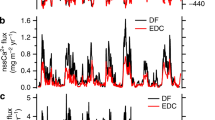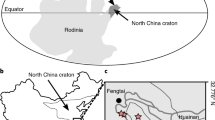Abstract
A quantitative understanding of sources and sinks of fixed nitrogen in low-oxygen waters is required to explain the role of oxygen-minimum zones (OMZs) in controlling the fixed nitrogen inventory of the global ocean. Apparent imbalances in geochemical nitrogen budgets1 have spurred numerous studies to measure the contributions of heterotrophic and autotrophic N2-producing metabolisms (denitrification and anaerobic ammonia oxidation, respectively)2,3. Recently, ‘cryptic’ sulphur cycling was proposed as a partial solution to the fundamental biogeochemical problem of closing marine fixed-nitrogen budgets in intensely oxygen-deficient regions4. The degree to which the cryptic sulphur cycle can fuel a loss of fixed nitrogen in the modern ocean requires the quantification of sulphur recycling in OMZ settings. Here we provide a new constraint for OMZ sulphate reduction based on isotopic profiles of oxygen (18O/16O) and sulphur (33S/32S, 34S/32S) in seawater sulphate through oxygenated open-ocean and OMZ-bearing water columns. When coupled with observations and models of sulphate isotope dynamics and data-constrained model estimates of OMZ water-mass residence time, we find that previous estimates for sulphur-driven remineralization and loss of fixed nitrogen from the oceans are near the upper limit for what is possible given in situ sulphate isotope data.
This is a preview of subscription content, access via your institution
Access options
Subscribe to this journal
Receive 51 print issues and online access
$199.00 per year
only $3.90 per issue
Buy this article
- Purchase on Springer Link
- Instant access to full article PDF
Prices may be subject to local taxes which are calculated during checkout



Similar content being viewed by others
References
Codispoti, L. A. Is the ocean losing nitrate? Nature 376, 724 (1995)
Lam, P. et al. Revising the nitrogen cycle in the Peruvian oxygen minimum zone. Proc. Natl Acad. Sci. USA 106, 4752–4757 (2009)
Ward, B. B. et al. Denitrification as the dominant nitrogen loss process in the Arabian Sea. Nature 461, 78–81 (2009)
Canfield, D. E. et al. A cryptic sulfur cycle in oxygen-minimum–zone waters off the Chilean coast. Science 330, 1375–1378 (2010)
DeVries, T., Deutsch, C., Rafter, P. A. & Primeau, F. Marine denitrification rates determined from a global 3-D inverse model. Biogeosciences 10, 2481–2496 (2013)
Jorgensen, B. B. Theoretical model of the stable isotope distribution in marine sediments. Geochim. Cosmochim. Acta 43, 363–374 (1979)
Johnston, D. T. Multiple sulfur isotopes and the evolution of Earth’s surface sulfur cycle. Earth Sci. Rev. 106, 161–183 (2011)
Wankel, S. D., Bradley, A. S., Eldridge, D. L. & Johnston, D. T. Determination and application of the equilibrium oxygen isotope effect between water and sulfite. Geochim. Cosmochim. Acta 125, 694–711 (2014)
Turchyn, A. V. & Schrag, D. P. Oxygen isotope constraints on the sulfur cycle over the past 10 million years. Science 303, 2004–2007 (2004)
Paytan, A., Kastner, M., Campbell, D. & Thiemens, M. H. Sulfur isotopic composition of Cenozoic seawater sulfate. Science 282, 1459–1462 (1998)
Mizutani, Y. & Rafter, T. A. Oxygen isotopic composition of sulphates. 4. Bacterial fractionation of oxygen isotopes in reduction of sulphate and in oxidation of sulphur. N. Z. J. Sci. 12, 60–68 (1969)
Fritz, P., Basharmal, G. M., Drimmie, R. J., Ibsen, J. & Qureshi, R. M. Oxygen isotope exchange between sulfate and water during bacterial reduction of sulfate. Chem. Geol. 79, 99–105 (1989)
Aharon, P. & Fu, B. S. Microbial sulfate reduction rates and sulfur and oxygen isotope fractionations at oil and gas seeps in deepwater Gulf of Mexico. Geochim. Cosmochim. Acta 64, 233–246 (2000)
Aharon, P. & Fu, B. S. Sulfur and oxygen isotopes of coeval sulfate-sulfide in pore fluids of cold seep sediments with sharp redox gradients. Chem. Geol. 195, 201–218 (2003)
Turchyn, A. V., Sivan, O. & Schrag, D. P. Oxygen isotopic composition of sulfate in deep sea pore fluid: evidence for rapid sulfur cycling. Geobiology 4, 191–201 (2006)
Wortmann, U. G., Bernasconi, S. M. & Bottcher, M. E. Hypersulfidic deep biosphere indicates extreme sulfur isotope fractionation during single-step microbial sulfate reduction. Geology 29, 647–650 (2001)
Wortmann, U. G. et al. Oxygen isotope biogeochemistry of pore water sulfate in the deep biosphere: dominance of isotope exchange reactions with ambient water during microbial sulfate reduction (ODP Site 1130). Geochim. Cosmochim. Acta 71, 4221–4232 (2007)
Farquhar, J., Canfield, D. E., Masterson, A., Bao, H. & Johnston, D. Sulfur and oxygen isotope study of sulfate reduction in experiments with natural populations from Faellestrand, Denmark. Geochim. Cosmochim. Acta 72, 2805–2821 (2008)
Mangalo, M., Meckenstock, R. U., Stichler, W. & Einsiedl, F. Stable isotope fractionation during bacterial sulfate reduction is controlled by reoxidation of intermediates. Geochim. Cosmochim. Acta 71, 4161–4171 (2007)
Antler, G., Turchyn, A. V., Rennie, V., Herut, B. & Sivan, O. Coupled sulfur and oxygen isotope insight into bacterial sulfate reduction in the natural environment. Geochim. Cosmochim. Acta 118, 98–117 (2013)
DeVries, T., Deutsch, C., Primeau, F., Chang, B. & Devol, A. Global rates of water-column denitrification derived from nitrogen gas measurements. Nature Geosci. 5, 547–550 (2012)
Kalvelage, T. et al. Nitrogen cycling driven by organic matter export in the South Pacific oxygen minimum zone. Nature Geosci. 6, 228–234 (2013)
Lavik, G. et al. Detoxification of sulphidic African shelf waters by blooming chemolithotrophs. Nature 457, 581–584 (2009)
Schunck, H. et al. Giant hydrogen sulfide plume in the oxygen minimum zone off Peru supports chemolithoautotrophy. PLoS ONE 8 http://dx.doi.org/10.1371/journal.pone.0068661 (2013)
Mandernack, K. W., Krouse, H. R. & Skei, J. M. A stable sulfur and oxygen isotopic investigation of sulfur cycling in an anoxic marine basin, Framvaren Fjord, Norway. Chem. Geol. 195, 181–200 (2003)
Mikucki, J. A. et al. A contemporary microbially maintained subglacial ferrous ‘ocean’. Science 324, 397–400 (2009)
Casciotti, K. L., Buchwald, C. & McIlvin, M. Implications of nitrate and nitrite isotopic measurements for the mechanisms of nitrogen cycling in the Peru oxygen deficient zone. Deep Sea Res. Part I Oceanogr. Res. Pap. 80, 78–93 (2013)
Walsh, D. A. et al. Metagenome of a versatile chemolithoautotroph from expanding oceanic dead zones. Science 326, 578–582 (2009)
Sigman, D. M. et al. Coupled nitrogen and oxygen isotope measurements of nitrate along the eastern North Pacific margin. Glob. Biogeochem. Cycles 19, (2005)
Saito, M. A., Moffett, J. W. & DiTullio, G. R. Cobalt and nickel in the Peru upwelling region: a major flux of labile cobalt utilized as a micronutrient. Glob. Biogeochem. Cycles 18, GB4030 (2004)
Forrest, J. & Newman, L. Ag 110 microgram sulfate analysis for short time resolution of ambient levels of sulfur aerosols. Anal. Chem. 49, 1579–1584 (1977)
Strickland, J. D. H. & Parsons, T. R. A practical handbook of seawater analysis. Bull. Fish. Res. Bd Can. 2, 1–310 (1972)
Garside, C. A chemi-luminescent technique for the determination of nanomolar concentrations of nitrate and nitrite in sea-water. Mar. Chem. 11, 159–167 (1982)
Casciotti, K. L., Sigman, D. M., Hastings, M. G., Bohlke, J. K. & Hilkert, A. Measurement of the oxygen isotopic composition of nitrate in seawater and freshwater using the denitrifier method. Anal. Chem. 74, 4905–4912 (2002)
Sigman, D. M. et al. A bacterial method for the nitrogen isotopic analysis of nitrate in seawater and freshwater. Anal. Chem. 73, 4145–4153 (2001)
Granger, J. & Sigman, D. M. Removal of nitrite with sulfamic acid for nitrate N and O isotope analysis with the denitrifier method. Rapid Commun. Mass Spectrom. 23, 3753–3762 (2009)
McIlvin, M. R. & Casciotti, K. L. Technical updates to the bacterial method for nitrate isotopic analyses. Anal. Chem. 83, 1850–1856 (2011)
Bottcher, M. E. The stable isotopic geochemistry of the sulfur and carbon cycles in a modern karst environment. Isotopes Environ. Health Stud. 35, 39–61 (1999)
Bottcher, M. E., Oelschlager, B., Hopner, T., Brumsack, H. J. & Rullkotter, J. Sulfate reduction related to the early diagenetic degradation of organic matter and ‘black spot’ formation in tidal sandflats of the German Wadden Sea (southern North Sea): stable isotope (C-13, S-34,O-18) and other geochemical results. Org. Geochem. 29, 1517–1530 (1998)
Knoller, K. et al. Sulfur cycling and biodegradation in contaminated aquifers: insights from stable isotope investigations. Environ. Sci. Technol. 42, 7807–7812 (2008)
Brand, W. A. et al. Comprehensive inter-laboratory calibration of reference materials for delta O-18 versus VSMOW using various on-line high-temperature conversion techniques. Rapid Commun. Mass Spectrom. 23, 999–1019 (2009)
Ku, T. C. W., Walter, L. M., Coleman, M. L., Blake, R. E. & Martini, A. M. Coupling between sulfur recycling and syndepositional carbonate dissolution: Evidence from oxygen and sulfur isotope composition of pore water sulfate, South Florida Platform, USA. Geochim. Cosmochim. Acta 63, 2529–2546 (1999)
Longinelli, A. in Handbook of Environmental Isotope Geochemistry Vol. 3 (ed. Fritz, P. & Fontes, J. C. ) 219–256 (Elsevier, 1989)
Aller, R. C., Madrid, V., Chistoserdov, A., Aller, J. Y. & Heilbrun, C. Unsteady diagenetic processes and sulfur biogeochemistry in tropical deltaic muds: implications for oceanic isotope cycles and the sedimentary record. Geochim. Cosmochim. Acta 74, 4671–4692 (2010)
Lloyd, R. M. Oxygen-18 composition of oceanic sulfate. Science 156, 1228–1231 (1967)
Longinelli, A. & Craig, H. Oxygen-18 variations in sulfate ions in sea water and saline lakes. Science 156, 56–59 (1967)
Cortecci, G., Molcard, R. & Noto, P. Isotopic analysis of deep structure in Tyrrhenian Sea. Nature 250, 134–136 (1974)
Zak, I., Sakai, H. & Kaplan, I. R. In Isotope Marine Chemistry (eds Goldberg, E. D., Horibe, Y. & Saruhashi, K. ) 339–373 (Rokakuho, 1980)
Brunner, B., Bernasconi, S. M., Kleikemper, J. & Schroth, M. H. A model for oxygen and sulfur isotope fractionation in sulfate during bacterial sulfate reduction processes. Geochim. Cosmochim. Acta 69, 4773–4785 (2005)
Muller, I. A., Brunner, B., Breuer, C., Coleman, M. A. & Bach, W. The oxygen isotope equilibrium fractionation between sulfite species and water. Geochim. Cosmochim. Acta 120, 562–581 (2013)
Leavitt, W. D., Bradley, A. S., Halevy, I. & Johnston, D. T. Influence of sulfate reduction rates on the Phanerozoic sulfur isotope record. Proc. Natl Acad. Sci. USA 110, 11244–11249 (2013)
Codispoti, L. A. & Christensen, J. P. Nitrification, denitrification and nitrous-oxide cycling in the eastern tropical South-Pacific Ocean. Mar. Chem. 16, 277–300 (1985)
Zamora, L. M. et al. Nitrous oxide dynamics in low oxygen regions of the Pacific: insights from the MEMENTO database. Biogeosciences 9, 5007–5022 (2012)
Olson, D. B., Hitchcock, G. L., Fine, R. A. & Warren, B. A. Maintenance of the low-oxygen layer in the central Arabian Sea. Deep Sea Res. Part II Top. Stud. Oceanogr. 40, 673–685 (1993)
Canfield, D. E., Thamdrup, B. & Kristensen, E. Aquatic Geomicrobiology 640 (Elsevier, 2005).
Acknowledgements
We thank the Johnston laboratory, B. Chang, S. Wankel, D. Canfield and J. Granger for discussions and comments; D. Capone and M. Prokopenko for sample collection (all supported by National Science Foundation (NSF) Division of Ocean Sciences); and G. Henderson, W. Homoky and GEOTRACES. Funding was provided by Harvard University (D.T.J., A.M.), the Agouron Institute (D.T.J., B.C.G.) and the NSF EAR-I/F (D.T.J., E.B.) and NSF/OCE grant nos 1140404 (K.L.C.) and 0850905 (A.N.K.).
Author information
Authors and Affiliations
Contributions
D.T.J. and B.C.G. developed the project. W.B. and K.L.C. provided samples with the help of W. Homoky and G. Henderson (GEOTRACES). B.C.G., A.M. and E.B. performed the analyses. K.C. and A.N. performed nitrogen measurements with assistance from M. Forbes. D.T.J. and A.M. performed all modelling. All authors contributed to the writing of the manuscript.
Corresponding author
Ethics declarations
Competing interests
The authors declare no competing financial interests.
Extended data figures and tables
Extended Data Figure 1 Test of whether changes in sulphate concentrations (although small) are related to salinity (here in practical salinity units).
A significant but weak correlation exists (P = 0.0075): see the text for discussion.
Extended Data Figure 2 Plot of sulphate concentrations against isotopic composition of sulphate.
The lack of a correlation is consistent with no overall heterogeneity in the ocean, especially as a function of sulphate reduction or sulphide oxidation, which would impart the characteristic 18O effect.
Extended Data Figure 3 Series of figures demonstrating the severity of oxygen deficiency at stations 11 and 25.
This is reflected both in nutrient budgets, tracked with N*, and in isotopes (in δ15N). Data are presented for both stations 11 and 25.
Extended Data Figure 4 Rank order box-and-whisker presentation of δ18Osulphate data for the ten water columns studied.
Data are discussed in the text. At the far right is a representation of all the data. Whiskers are 95% confidence intervals around a given median value (black bars at the centre of the boxes).
Extended Data Figure 5 Replotting of Fig. 3 with two different choices for δ18Os.c..
One estimate is based on s.e.m.; the other is based on the uncertainty over the entire global data set.
Extended Data Figure 6 Isotopic predictions for sulphate cycling as a function of water mass transit time.
The contour key shows various residence times of water within oxygen-deficient waters.
Extended Data Figure 7 The link between nitrogen and sulphur.
a, Prediction for sulphate reduction rates for a cryptic sulphur cycle containing 1 mmol m−2 d−1 sulphate reduction. b, Prediction for nitrate consumption rate. All biogeochemistry is arbitrarily distributed over a path length of 200 m. Units were chosen to be directly comparable to those in Table 1 of ref. 4.
Source data
Rights and permissions
About this article
Cite this article
Johnston, D., Gill, B., Masterson, A. et al. Placing an upper limit on cryptic marine sulphur cycling. Nature 513, 530–533 (2014). https://doi.org/10.1038/nature13698
Received:
Accepted:
Published:
Issue Date:
DOI: https://doi.org/10.1038/nature13698
This article is cited by
-
Changes in the membrane lipid composition of a Sulfurimonas species depend on the electron acceptor used for sulfur oxidation
ISME Communications (2022)
-
A 200-million-year delay in permanent atmospheric oxygenation
Nature (2021)
-
Oxygen isotope effects during microbial sulfate reduction: applications to sediment cell abundances
The ISME Journal (2020)
-
The Isotopic Imprint of Life on an Evolving Planet
Space Science Reviews (2020)
-
Sulphur and carbon cycling in the subduction zone mélange
Scientific Reports (2018)
Comments
By submitting a comment you agree to abide by our Terms and Community Guidelines. If you find something abusive or that does not comply with our terms or guidelines please flag it as inappropriate.



